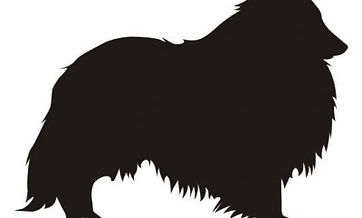The journey of life is sweeter, when travelled with a dog

The History of the Sheltie
The modern day Shetland Sheepdog is a short, bright, energetic dog with a distinctive long coat which comes in a variety of colours – mainly tri-colour, sable and blue merle. Although these dogs have proven to be great workers in the modern day world with a keen interest in herding livestock often twice their size, their original purpose in Shetland was very different. In fact, the dog you see now looks VERY different to the ones originally kept by crofters many years ago!
Although there is very little strong evidence towards the early days of the breed, the original dogs kept by crofters in Shetland have been said to be originating from the Scandinavian herding dog class, including the Norwegian Buhund and Icelandic dog (they have been closely linked with Spitz type). These dogs would have been brought into Shetland when the original Norse settlers came with their livestock.
When Shetland was given to Scotland as a dowry and trade began between them, larger breeds of livestock were introduced to the islands. With them, the ancestors of the boarder collie also came and local farmers bred their dogs with them to produce a dog with increased agility and speed. These dogs were also crossed with those coming from fishing boats visiting the islands – the Greenland Yakki has been specifically mentioned as contributing to the breed.
These powerful, resilient little dogs were used by crofters to protect their crops from hungry livestock: Shetland sheep, Shetland bred cattle and of course Shetland ponies (also confusingly nicknamed "shelties"). They were trained to defend their patch, often left on their own accord, warding off any animals which came close by nipping at their heels. Their physique made them the perfect candidates – able to beetle their way through the vegetation whilst being light enough that they wouldn’t cause damage. Their irrepressible, strong will contained in their character has never been lost since then and is one of the things that their owners today cherish most. Back then, they were known as the “Toonie dug” (“toon” meaning “field” in the old Shetland language [not to be mixed up with the Scottish “toon” which means “town”!]).
During the 19th century, tourism became an important factor for the Shetland economy. Farmers figured that they could sell their little dogs and began breeding them with anything small and fluffy to make them more “cute” and valuable – mainly Pomeranians, although there has also been a link to a king Charles Spaniel. This continued until the early 20th century, when some of the islanders realised that the “original” breed was disappearing. In an attempt to reclaim the look of the old authentic dog, they began reproducing with the collie again and selective breeding with those containing closest resemblance to the native species.
There was a large controversy towards the name of the local dog at this time. Proud breeders of show collies in Scotland refused to call these little “mongrels”, “Shetland Collies” – suggesting a close resemblance to their own perfected breed. For this reason, Shelties were then referred to as “Shetland Sheepdogs” in order to settle any arguments.
The first registered sheltie through the Kennel Club was a bitch named Badenock Rose and occurred in 1909. A total of 28 Shelties were registered thereafter in this same year and four from this list can be linked to modern Champions – “Lerwick Tim” and “Lerwick Trim” are two of them.
From here, the breed continued to develop and grow. The Shetland Sheepdog is now a well established member of the pastoral group in show and very much a loved member of the family in many homes as a pet around the world.
For those of us who happen to own this brilliant, unique breed, we know that there are parts of their nature which forms a very strong part of them. Their desire to chase often becomes a challenge when trying to train them and they are often found “herding” a family around the house – never contented until everyone is “safe” in the same room! Another part of their character which has survived through time is their undying devotion and loyalty to their owner. It is no wonder they made the perfect companions on the farm. Today, the sheltie has been replaced by boarder collies on local farms due to modern livestock being much bigger and more powerful. Instead, they enjoy a more “luxury” lifestyle as pets in our homes!
For those who want to experience where the ancestors of these little dogs once worked, visit one of Shetland's original crofts! Click on the images below to find out more:












































Above are genuine images from Shetland's past featuring some of the original Shelties who lived and worked in Shetland.
They are taken from the Shetland museum's wonderful archive of photos which can viewed here:
http://www.shetlandmuseumandarchives.org.uk/collections/archive

Shelties from around the world!
We've come a long way from being little crofter's dogs in shetland!
Check out our friends from around the world
 Dustin from XXX - I'm active and love flyball! |  Describe your image. |  Describe your image. |
|---|---|---|
 Describe your image. |  Describe your image. |  Describe your image. |
